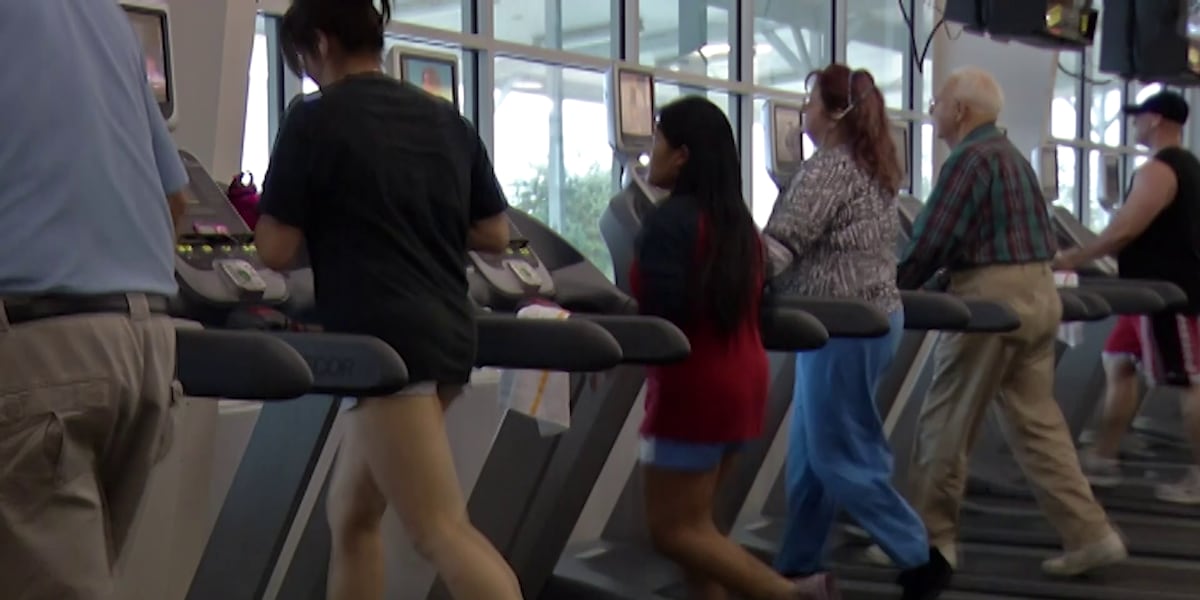Fitness
This Echelon Smart Exercise Bike is over $400 off today on Amazon

Biking as exercise is great for many reasons: the feel of the wind in your hair, the thrill of exploring your neighborhood and beyond.
But here’s what they don’t tell you: when you hop on a bike, the world falls away, and when you come to a stop later, you might be miles away from home. Then you’re in a bind: even if you don’t want to keep biking, even if your quads are burning, you have to bike back home.
Luckily, there’s a solution: the stationary exercise bike, like this Echelon Smart Connection Fitness Bike, available for a whopping 43% off today on Amazon.
Save over $400, and never find yourself stranded again when you pick up this jaw-dropping deal on an exercise bike from Echelon. Designed to work with the Echelon Fit App, this exercise bike deal comes with 30 free days of an Echelon Premier Membership, including over 3,000 live and on-demand classes, including courses on endurance, climbing, and scenic rides.
Don’t let this deal bike past you. Scroll down, click through, and save on cycling today on Amazon.
The makers of the Echelon Smart Connect Fitness Bike are so confident that you’ll love your purchase, they promise a 30-day 100% money back guarantee, if for some reason you don’t fall in love with the Echelon’s ergonomic handlebars, extra-large cushioned seat, and performance-optimized pedals. Though we find that unlikely.
For more content, check out the New York Post shopping section.

Fitness
Can a

Exercising regularly is important for preventing dementia. But if it’s hard to rack up the recommended amount of activity during the five-day work week (150 minutes of moderate-intensity activity, like brisk walking, or 75 minutes of vigorous activity, like swimming), consider the “weekend warrior” approach — fitting it all into one or two weekly sessions. The approach might offer the same brain health benefits, according to a study published online Oct. 29, 2024, by the British Journal of Sports Medicine. Researchers analyzed the health and self-reported activity information of more than 10,000 dementia-free people in Mexico who were followed for about 16 years. After accounting for factors that could influence the results, such as lifestyle habits, scientists found that weekend warriors were 13% less likely to develop mild cognitive impairment (MCI), a precursor to dementia, compared with people who didn’t exercise — about the same benefit seen in those who exercised during the work week. While the study was observational and can’t prove cause and effect, it supports the idea that even less frequent exercise might help protect brain health, and it might be a more convenient option for busy people.
Image: © Luis Alvarez/Getty Images
As a service to our readers, Harvard Health Publishing provides access to our library of archived content. Please note the date of last review or update on all articles.
No content on this site, regardless of date, should ever be used as a substitute for direct medical advice from your doctor or other qualified clinician.
Fitness
Fitness face-off – Harvard Health

What’s in style? The question doesn’t just relate to fashion. Indeed, even exercise styles go in and out of vogue, echoing trends fueled by social media and other cultural drivers.
Case in point: high-intensity bursts of exercise have grabbed headlines over the past couple of years, with scientists generating an array of studies examining the health benefits of short spurts of movement lasting from one to three minutes. That might consist of jumping jacks, lunges, running in place, jumping rope, air boxing, running up stairs, or any other high-intensity activity.
Meanwhile, plenty of research continues to focus on the health advantages of moderate-intensity, continuous movement. Mainstay choices for these sessions include brisk walking, cycling, jogging, and elliptical and treadmill use.
Given the swings in popularity between the differently paced alternatives, perhaps the most pressing question is which one is better for us. It might seem certain exercise patterns might prove superior to others, but we should resist the temptation to believe that, says Dr. Meagan Wasfy, a sports cardiologist at Harvard-affiliated Massachusetts General Hospital.
“There are always trends, and each one claims to be the latest and best way to move your body,” Dr. Wasfy says.
Breaking down the data
What health benefits does each approach offer? A sampling of recent studies and official health guidance weighs in.
Evidence supporting exercise bursts includes the following:
- A 2022 analysis of data collected on more than 25,200 people who didn’t otherwise exercise (average age 62, 56% women) published in Nature Medicine found that those who routinely did brief bursts of vigorous activity — defined as three bouts, each lasting a minute or two — had significantly lower odds of dying or developing cardiovascular disease over the following seven years than participants who didn’t.
- A 2023 analysis in JAMA Oncology of more than 22,000 people who didn’t exercise (average age 62, 55% women) suggested that even short, intermittent periods of intense movement — a minute at a time, three or four times a day — was linked with 18% lower cancer risk over the following 6.7 years, especially for cancers of the breast, uterus, or colon.
Evidence supporting longer, moderate-intensity exercise includes the following:
- Adults who do any amount of moderate-to-vigorous exercise derive health benefits, including reducing their risks of cardiovascular disease, diabetes, and some forms of cancer, according to the CDC.
- A 2022 analysis in JAMA Internal Medicine involving 78,000 people (average age 61, 55% women) found their risk of heart disease, cancer, and premature death dropped by 10% over the following seven years for every 2,000 steps they logged each day, with the benefit peaking at 10,000 steps.
Sense a theme from the findings? Regardless of intensity, it’s apparent that any movement is good for your health.
“No one comes out ahead with regards to the long-term outcomes,” Dr. Wasfy says. “What matters most is moving your body and doing more of it. The sum of movement, over the course of a year or decades of your life, is what matters.”
Exercise caveats
One clear advantage to exercise bursts — or its cousin, high-intensity interval training (HIIT) — is that any high-intensity activity enables you to fulfill recommended exercise guidelines in less time. Health organizations advise adults to get at least 150 minutes of moderate exercise or 75 minutes of vigorous exercise (or some equivalent combination of the two) per week. For an HIIT workout, you alternate vigorous, short sprints with brief periods of rest or lower-intensity movement.
“It’s a time-efficient way to get your recommended exercise dose in less time,” Dr. Wasfy says.
High-intensity exercise does pose a few drawbacks, however. These include a greater risk of injuries and inflammation to joints and muscles. Additionally, for people with heart disease or its risk factors, sudden bursts of exercise could be more likely to bring on new cardiac symptoms.
“If you’re writing an exercise prescription not knowing anything about someone’s health history, you’d write it for moderate-intensity, continuous exercise,” Dr. Wasfy says.
If you’d like to increase your exercise intensity but have existing heart disease — or symptoms such as chest pain with vigorous movement — talk to your doctor in advance. Older adults who’ve noticed their ability to exercise has declined should also speak up.
Ultimately, Dr. Wasfy says, you should choose a style of exercise you really like — and will do consistently — and disregard fitness trends. “If you’re healthy,” she says, “it’s really your choice.”
Image: © Luis Alvarez/Getty Images
Fitness
Amitabh Bachchan’s diet and workout routine for staying fit at 82: Pranayam, yoga stretches, gooseberry juice and more

Amitabh Bachchan is a living legend whose popularity surpasses that of his contemporaries. At 82, his unmatched energy and commitment to fitness continue to inspire generations. Despite facing severe health challenges like tuberculosis, his disciplined lifestyle has helped him stand tall and active in the industry. Curious to know the secret behind his fitness? Let’s dive into the insights of Amitabh Bachchan’s diet plan and workout routine. (Also read: Sonu Sood shares his diet and fitness secrets for toned body at 51: ‘I’ve never tasted non-veg and I don’t drink’ )
How Amitabh Bachchan stays fit at 82
Earlier, in an interview with Humans of Bombay, Amitabh Bachchan’s wellness trainer Vrindaa Mehta revealed the actor’s unwavering dedication to fitness. She shared, “If Amitabh Bachchan can make time to exercise, normal people can too. The mindset is, when you know something is good for you, you just do it. It’s not about comfort, it’s not about not having time… If Mr. Bachchan can make time to exercise, regular people can of course, take out time to exercise.”
Talking about his fitness routine, Vrindaa added, “My sessions with Amit ji are more about breath work. We start off with basic breath exercises and move on to pranayams, and basic yoga stretches. Mindset… He’s the father of it all.”
Wellness trainer Shivohaam, who also works with Amitabh, highlighted the actor’s remarkable commitment to fitness. “There are times when we have to tell him, ‘Let’s not train right now, it’s not ideal for you.’ The point is, he does take out the time, whether it’s morning, afternoon, or evening, or even between meetings because he knows it’s important,” shared Shivohaam.
Amitabh Bachchan’s diet secrets
Amitabh Bachchan’s diet revolves around discipline and variety. In one of his blog posts, the veteran actor shared that he begins his day with tulsi leaves, followed by a breakfast featuring items like protein shakes, almonds, porridge, or coconut water. Other favourites include gooseberry juice and dates, providing a power-packed start to his mornings with a mix of healthy nuts and proteins.
When discussing his eating habits, Big B revealed, “In my youth, I would eat, but now I have left eating non-veg dishes, sweet items, rice, and won’t speak any further.” Skipping desserts and limiting sugar intake have been significant lifestyle changes that help him maintain his fitness and avoid risks like obesity.
-
/cdn.vox-cdn.com/uploads/chorus_asset/file/25822586/STK169_ZUCKERBERG_MAGA_STKS491_CVIRGINIA_A.jpg)
/cdn.vox-cdn.com/uploads/chorus_asset/file/25822586/STK169_ZUCKERBERG_MAGA_STKS491_CVIRGINIA_A.jpg) Technology1 week ago
Technology1 week agoMeta is highlighting a splintering global approach to online speech
-

 Science1 week ago
Science1 week agoMetro will offer free rides in L.A. through Sunday due to fires
-
/cdn.vox-cdn.com/uploads/chorus_asset/file/23935558/acastro_STK103__01.jpg)
/cdn.vox-cdn.com/uploads/chorus_asset/file/23935558/acastro_STK103__01.jpg) Technology1 week ago
Technology1 week agoAmazon Prime will shut down its clothing try-on program
-

 News1 week ago
News1 week agoMapping the Damage From the Palisades Fire
-
/cdn.vox-cdn.com/uploads/chorus_asset/file/25826211/lorealcellbioprint.jpg)
/cdn.vox-cdn.com/uploads/chorus_asset/file/25826211/lorealcellbioprint.jpg) Technology7 days ago
Technology7 days agoL’Oréal’s new skincare gadget told me I should try retinol
-
/cdn.vox-cdn.com/uploads/chorus_asset/file/25832751/2192581677.jpg)
/cdn.vox-cdn.com/uploads/chorus_asset/file/25832751/2192581677.jpg) Technology4 days ago
Technology4 days agoSuper Bowl LIX will stream for free on Tubi
-

 Business5 days ago
Business5 days agoWhy TikTok Users Are Downloading ‘Red Note,’ the Chinese App
-
/cdn.vox-cdn.com/uploads/chorus_asset/file/25835602/Switch_DonkeyKongCountryReturnsHD_scrn_19.png)
/cdn.vox-cdn.com/uploads/chorus_asset/file/25835602/Switch_DonkeyKongCountryReturnsHD_scrn_19.png) Technology2 days ago
Technology2 days agoNintendo omits original Donkey Kong Country Returns team from the remaster’s credits








/cdn.vox-cdn.com/uploads/chorus_asset/file/25345068/STK468_APPLE_ANTITRUST_CVIRGINIA_C.jpg)










